BigWaveDave
Gold Member
- Joined
- Nov 22, 2013
- Messages
- 9,444
- Reaction score
- 17,689
- Golden Thread
- 2
- Location
- Mountain Maryland
- 🥇 Banner finds
- 2
- 🏆 Honorable Mentions:
- 4
- Detector(s) used
- Garrett AT Pro, AT Max, Minelab
Equinox 800
- Primary Interest:
- Metal Detecting
My hunt today was a good...ooh! My first SBA, a 45 record insert, 11 wheats, And a couple of silvers...or so I thought.
The 1944 P war nickel has me scratching my head.
When I found it, it was tarnished pretty black, as they typically are pulled deep from the turf...but when I cleaned it up with soap and water, she shined up pretty clean...OK...?
When I unintentionally tossed it on the granite countertop, it didn't sound anything like I expected, literally a thud....OK....?
So I grabbed the other 8 war nickels I've found, and compared them....
The 8 had the light plink sound of I guess copper and silver alloy, but the new one, still, thud.
The weight of my 8 average 4.79 grams, accounting for wear, should be 5 grams. The new one, 4.5 grams, but not nearly the wear as others.
The silver test kit revealed a black stain on the cotton, not red, indicative of silver...
Now guy, this is the kicker...I have NEVER found a nickel that rang up as a 75 on the At Pro...
All the other ones, a solid 55, this one, when I found it, thought I was pulling a wheat. Sure enough, scanned it again, compared to the others, still 75.... WTF?
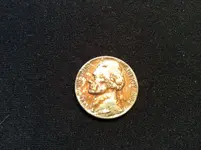
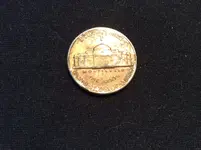
Compared to the others...
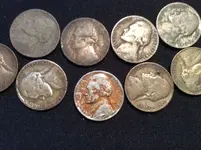
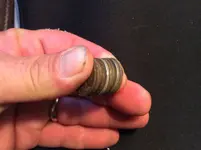
None of the pieces respond to a magnet, nor should they...
The Henning Counterfeit was my first inclination, but the P mint mark is on the reverse, telling me it's not a Henning...but what is it?
The 75 on the detector has me baffled.
So, tell me what you think, oh, pics of other finds, for your enjoyment...
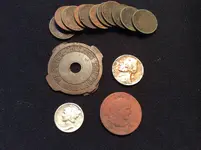
Thanks for looking!
The 1944 P war nickel has me scratching my head.
When I found it, it was tarnished pretty black, as they typically are pulled deep from the turf...but when I cleaned it up with soap and water, she shined up pretty clean...OK...?
When I unintentionally tossed it on the granite countertop, it didn't sound anything like I expected, literally a thud....OK....?
So I grabbed the other 8 war nickels I've found, and compared them....
The 8 had the light plink sound of I guess copper and silver alloy, but the new one, still, thud.
The weight of my 8 average 4.79 grams, accounting for wear, should be 5 grams. The new one, 4.5 grams, but not nearly the wear as others.
The silver test kit revealed a black stain on the cotton, not red, indicative of silver...
Now guy, this is the kicker...I have NEVER found a nickel that rang up as a 75 on the At Pro...
All the other ones, a solid 55, this one, when I found it, thought I was pulling a wheat. Sure enough, scanned it again, compared to the others, still 75.... WTF?



Compared to the others...


None of the pieces respond to a magnet, nor should they...
The Henning Counterfeit was my first inclination, but the P mint mark is on the reverse, telling me it's not a Henning...but what is it?
The 75 on the detector has me baffled.
So, tell me what you think, oh, pics of other finds, for your enjoyment...

Thanks for looking!

Amazon Forum Fav 👍
Upvote
15




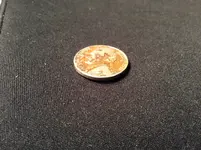
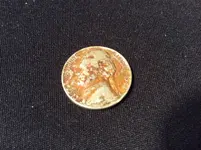
 ...I think I have just solved this mystery. Back in the olden days "a shiny new nickle" was something you gave a child if they were good, but nickles tarnish so unless you had a mint condition nickle it would not be shiny. What if someone decided to make the new silver war nickle even shinier - a super shiny nickle if you will? I think your coin is just a regular war nickle that someone silver plated. The added silver layer would account for both the extra weight and the higher tone on the detector. It would also explain how the coin emerged relatively clean and shiny as the silver-plate outer layer would not tarnish if the soil was sufficiently anaerobic.
...I think I have just solved this mystery. Back in the olden days "a shiny new nickle" was something you gave a child if they were good, but nickles tarnish so unless you had a mint condition nickle it would not be shiny. What if someone decided to make the new silver war nickle even shinier - a super shiny nickle if you will? I think your coin is just a regular war nickle that someone silver plated. The added silver layer would account for both the extra weight and the higher tone on the detector. It would also explain how the coin emerged relatively clean and shiny as the silver-plate outer layer would not tarnish if the soil was sufficiently anaerobic. 

